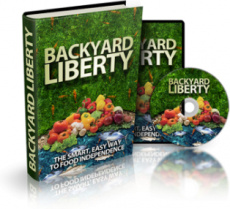Backyard Liberty Ebook
Backyard Liberty
Category: Self Defense, Self Help
Title: Backyard Liberty
Description:
Title: Backyard Liberty
Description:
The opportunity to keep your family healthy and well fed when the coming food collapse strikes is just too important to ignore.
You Will Achieve Total Food Independence In Less Than 28 Days...
Here's what's inside Backyard Liberty...
- The in-depth video instructions practically builds your aquaponics for you. You'll use only common parts and supplies that can be found in your local hardware store, and the whole system costs $190 to make.
- A step-by-step video guide showing you in EXPLICIT detail how to create your own pocket sized "Garden of Eden." Gain a never ending supply of drippingly-fresh fish and produce that will keep your family healthy during the coming food collapse.
- Anyone can do this. The instructions are so easy and the construction is so simple. And because you'll be growing your vegetables in raised bed, even those with bad backs or joint pain will have no trouble building this life-saving system.
- Enjoy high protein and vitamin-rich foods from your own backyard. While others are digging through dumpsters for scraps, your loved ones will be sleeping soundly in their own beds with food in their stomachs...
- Save thousands of dollars compared to paying for your own stockpile. Be free from the worries of your food sources expiring, and have delicious, tasty meals 3 times a day – instead of soggy, salty canned vegetables...
- It's a low input, high output food generating system. Do one 10 minute maintenance checkup every day, and never worry about where your next meal will come from...
- And it's all natural. No pesticides, no fertilizers, and no chemicals, just the freshest carrots, tomatoes, lettuce, squash, potatoes, fresh fish, and other foods that you've ever tasted.
- You'll cut your grocery bill by up to 90% in just 4 short weeks. You'll never need to buy fish from the store again, and you'll never need to pay for several week old vegetables that have been shipped to the market from halfway across the world.
- Plus – your permanent pantry can be grown vertically, taking up 95% less space, and using only 10% of the water a traditional garden requires.
Rating:
Related Books:
 | Bulletproof Home Defense Author: Steve Walker Category: Home, Self Defense, Self Help Price: $37.00 |  | free Energy Options Create Electricity In Your Own Backyard! Category: Green Products, Hobbies, Home Price: $48.95 |
 | The Ultimate Guide to a Delicious Backyard BBQ Category: Cooking Price: $27.97 |  | SET AT LIBERTY Category: Christian Books Price: $14.00 |
 | Self Defense for Women Category: Self Defense, Women Price: $9.95 |  | Backyard Ideas Category: Children Price: $7.00 |
 | Self Defense 101 Category: Self Defense Price: $3.00 |  | Understanding The 3 Levels of Salvation: Spirit, Soul & Body Author: Everest John Alexander Category: Christian Books, Religion, Spirituality Price: $17.00 |
Site owner: Put the rating form on your site!
Listing wrong or need to be updated? Modify it.
Popular:
Top 20New
Free
Category:
Action (38)
Adventure (101)
Affiliates (40)
Animals (99)
Arts (48)
Auto (31)
Aviation (3)
Beauty (56)
Body (83)
Business (320)
Cats (19)
Child Custody (11)
Children (151)
Christian Books (81)
Classic (166)
Computers (40)
Cooking (182)
Cover design (3)
Crafts (45)
Decorating (19)
Diet (109)
Dogs (75)
E-Business (521)
E-Marketing (408)
Education (118)
Entertainment (93)
Family (72)
Fantasy (53)
Fiction (122)
Finance (83)
Fish and Fishing (37)
Fitness (162)
Food (86)
For Authors (54)
Forex (12)
Gambling (9)
Games (33)
Garden (68)
Golf (29)
Green Products (29)
Health (467)
History (31)
Hobbies (71)
Holidays (37)
Home (123)
Home Business (118)
Horror (23)
Horse (21)
How To (137)
Humor (32)
Illustrated Picture Books (5)
Internet (117)
Investing (39)
Jobs (71)
Law and Legal (13)
Management (15)
Manuals (64)
Marketing (24)
Medicine (57)
Men (43)
Military (7)
Mind (73)
Music (53)
Mystery (43)
Nature (32)
Nonfiction (70)
Novels (32)
Parenting (56)
Philosophy (23)
Photography (21)
Poetry (25)
Programming (30)
Psychology (117)
Real Estate (36)
Relationships (236)
Religion (69)
Remedies (70)
Romance (66)
SEO and Promotion (60)
Science (17)
Science Fiction (27)
Self Defense (35)
Self Help (285)
Spirituality (66)
Sports (73)
Thrillers (40)
Travel (78)
Wedding (21)
Weight Loss (97)
Women (121)
Young Adult (32)
Hide Menu
Related E-Books
eLibrary Awards:
Date: 3/5/2008
From: World Wide Web Awards™
E-Library has been selected to receive the World Wide Web Awards™ "Gold"Award.
The World Wide Web Gold Award represents web presence at its best.
Mistake found?
Select spelling error with your mouse and press Esc

